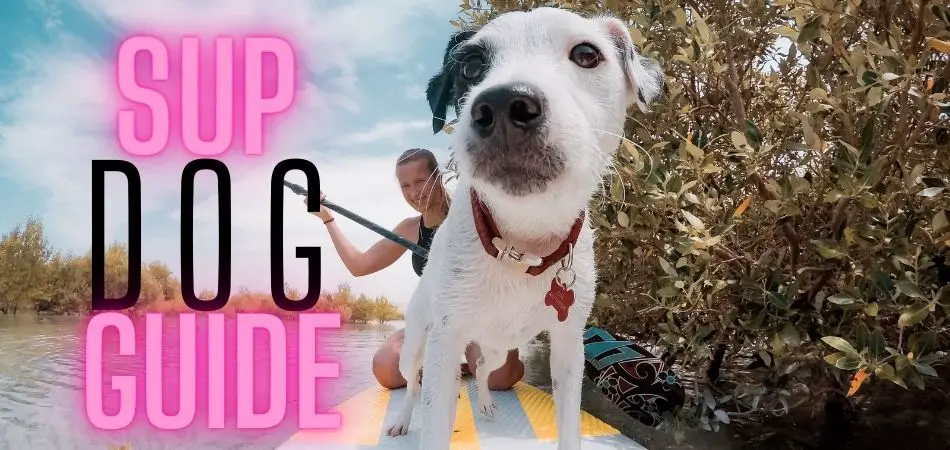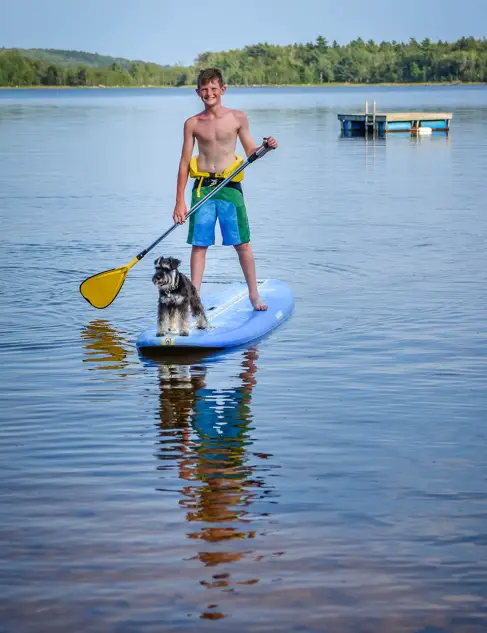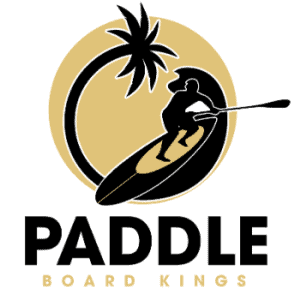Paddle boarding is a great way to get exercise and enjoy the outdoors with your dog. This guide will teach you everything you need to know about how to paddle board with your pup.
How to Paddle Board with Your Dog: A Complete Guide

1. Set up your board
This should be a no-brainer, but many people don’t consider that you will need to attach your dog’s leash before you can even start.
You should also be sure not only to have a well-fitting life jacket but one which is specifically made for dogs (and keep in mind they come in different sizes). Also, don’t forget about your dog’s sunscreen and water.
Your dog should be comfortable with the board before you even start getting on it, so don’t wait until you are already out in the open water to have them wear their life jacket or hop on for a ride.
If they aren’t good swimmers (which is not common), make sure that there are no options for them sinking below the surface of the water – this means your paddle board should be in good shape.
Ensure that any leash has quick-release buckles so you can get your pup off quickly if needed but also ensure that it isn’t too long as many dogs will try to swim toward you if they can’t reach the board.
2. Paddle with one hand while holding onto your dog’s leash in the other
To get your dog under control- because they may be too excited- paddle with one hand while holding onto your dog’s leash in the other.
If you have another person on the board people, it is possible that they can hold onto their leash, but this will depend upon how good of swimmers they are and also whether or not there are any serious riptides along your route.
Using a tether rather than just an ordinary leash is best so that if something does happen, they won’t be able to run out ahead of you (which could mean falling off).
You should practice these techniques before going out into open water because things like tides change quickly and may make paddling back difficult without some advanced planning. This means practicing at least once before you go out into the open water.
While it may seem like a good idea to let your dog ride on the front of your paddle board, be aware that they will likely move around, and this could cause an accident or injury for both of you. You should also make sure you have enough room between yourself and other boards (especially ones with dogs).
3. Give your dog plenty of time to explore and sniff around before you start paddling.
Your dog needs to get used to being on a paddle board, so give them plenty of time to explore and sniff around before you start paddling.
You should also ensure they have enough water (and food) when it’s hot out – this means taking care of both yourself and your pup to keep everyone safe from overheating or exhaustion.
While some dogs may love the exhilaration of being near the water- especially if there are waves- others will be frightened by all of the sounds that come along with open bodies of water.
If you suspect that your dog will be spooked during their first few rides, don’t take them into deep waters because chances are they won’t want anything more than getting back onto solid land as soon as possible.
You’ll know your dog loves it when they start wagging their tail, which will likely happen after just a few minutes.
If you are lucky enough to have a good pup in the water and not afraid of waves, be sure to let them run around on the board while it is unoccupied and only get back onto the paddle board once you are ready for another ride.
4. Keep an eye out for trash or debris that could hurt your pup, as well as any wildlife they might come across.
Be sure that you keep an eye out for any trash or debris that could potentially hurt your pup, as well as other wildlife they might come across. Remember to always respect the environment and be aware of anything you may disturb- this will help both your dog and yourself remain safe.
5. Keep your pup’s attention on you by using treats or a toy if necessary.
If they start looking distracted (which is likely when there are exciting things around), make sure their attention stays on you by using treats or holding onto their favorite toy until it is time to get back off again. Also, make sure you have a leash attached to them at all times and keep an eye on any other water traffic.
6. Stay close to shore so you can easily get back on land quickly if necessary.
You may have to paddle close to the shore if there are riptides in the area or if you have to get back on land quickly for another reason. This will also keep your dog safe from any large waves that might knock them off, as well as keeping both of you out of harm’s way.
While it may seem like a fun idea at first to let your pup ride alongside you while paddle boarding- remember these tips before taking them into open water to avoid injury and accidents.
Can You Take Dogs Paddle Boarding?
As discussed above, yes you can take your dog paddle boarding, but it’s important to keep certain things in mind during the process.

If you’re considering taking your dog paddle boarding, make sure they are not afraid of large bodies of water before doing so while also keeping an eye out for any wildlife that may be near or trash/debris that could potentially hurt them.
If possible, try practicing with your pup on a lake first to see how they react- this will help prevent problems later down the road when you do get onto open water.
Be sure to take extra precautions if there is riptide activity because dogs can easily become injured from trying to fight against these currents, even though humans shouldn’t have too much trouble making their way back (if necessary).
How Do I Get My Dog To Use A Paddle Board?
If your dog is not used to being on a paddle board, start by getting them accustomed to the feel of it. You can do this by placing it on the shore, so they have to jump onto it, or standing on it and coaxing them up.
Try attaching treats or toys in front of your dog when they are on the board. This is a good way to get them to stay on the board and not jump off when you tell them ‘stay.’
You can also try holding onto their leash if they are constantly jumping in or out of the water. Also, try to start slow and short with the sessions, so they don’t get too tired.
Let them walk around on the board for as long as they want before picking up all four paws off of it so they can’t run into the water.
If you have a good pup in the water and not afraid of waves, be sure to let them run around on your paddle board while it’s unoccupied and only get back onto it once you are ready for another ride.
Practice in shallow water so that it’s not too deep of a fall if they fall off. Practicing will also help your dog get accustomed to the board so that they have a better time riding it.
SUP Dog Training and Introduction to the Paddle Board
To train your dog to get onto a SUP, you need to go slow. I’ve seen people put their dog on and then take off almost immediately with the idea of just getting them used to it, but that’s not how they learn best.
I recommend putting your board on shallow water (like waist deep), so if they do fall over or jump off, there is no chance of injury. Make sure you have treats or toys ready as well. Dogs want what’s in your hand.
Small training sessions are all about building up trust between you and your pup. This way, they know good things come from being around the board. You can also try having them sit/stay before allowing them back into the house after playtime outside. This helps them learn that good things happen when they can’t have constant access to you.
How to introduce your dog to a paddle board for the first time
We have already discussed how to do this in previous sections. However, it is important to reiterate that you should start on a shallow body of water and have them get used to the board before going out into deeper waters.
You can also work your way up with longer training sessions, so they don’t tire themselves out too quickly. You’ll want this process to be an enjoyable experience for yourself and your dog rather than something stressful.
If you have a pup afraid of large bodies of water or new experiences, then it’s best to avoid taking them out onto open waters as this could lead to injury and panic attacks.
What You Will Need to Paddle Board with Your Dog
You will need a few things to take your pup out on the water with you. For obvious reasons, the board and leash are required, but it is also important to have a life jacket that fits them properly, so they don’t get swept away by currents or fall overboard.
You will want to invest in some treats as well because this can be used as a positive reinforcement when training them how to stay on the board while you’re paddling around.
If necessary, then having additional toys or something interesting like a ball would suffice too. You could even use their favorite toy if things get really difficult during training sessions – just remember which one it was so you know not to bring it along later.
Will My Dog Pop My Inflatable Paddle Board?
Inflatable boards are not indestructible or unbreakable – they can pop from pressure just like any other SUP (inflatable or solid). However, I’ve never had one pop on me when my pup was out riding with me.
I think that your best bet here is making sure you invest in high-quality gear, as well as doing some research online about how others have managed their dogs while using inflatables.
Training your dog also comes in handy here. If they are used to riding on your board, it’s less likely that they will cause the pressure point necessary for a puncture.
Which Type of Stand-Up Paddle Board Is Best For Dogs?
There aren’t any SUPs that are “better” for dogs. They all work fine as long as the rider knows what they’re doing and has a well-mannered pup with them to ride along. You just need to be aware of their capabilities and limitations, which you’ll get better at after some practice time on the water!
I recommend beginners start with an inflatable board because it’s easier to learn how things work before investing in something more expensive or having your dog run into trouble while you’re still figuring everything out.
What Is A Good Size Paddle Board For Dogs?
A standard, longer-sized board will work best when it comes to taking your dog paddle boarding- but be sure you have them on a leash at all times just in case something unexpected happens.
Final Thoughts
Paddle boarding with your dog is a good experience only if you know what you’re doing. This means having the proper gear, a good amount of experience with your pup (and making sure they are properly trained), and knowing how to handle them on the board if something goes wrong.
Now that you have all this information in one place, I hope you’ll be able to get out there and start exploring some great bodies of water with your favorite furry friend. And remember: always plan, so nothing unexpected happens when it comes time for takeoff.
